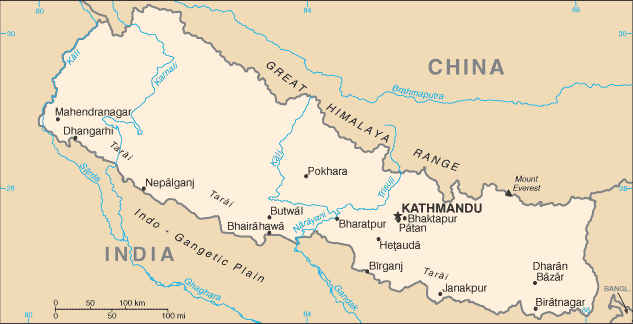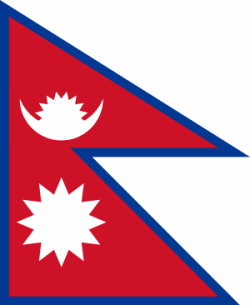Kingdom of Nepal
Related Categories:
 Nepal - Fotw
Nepal - FotwThe flag of Nepal is the only national flag which is not rectangular, being based upon two separate pennants which belonged to rival branches of the Rana dynasty.
www.fotw.us/
For a small territory, the Nepali landscape is uncommonly diverse, ranging from the humid Terai in the south to the lofty Himalayas in the north. Eight of the world's ten highest mountains are in Nepal, including Mount Everest.
en.wikipedia.org/
Perched on the southern slopes of the Himalayan Mountains, the Kingdom of Nepal is as ethnically diverse as its terrain of fertile plains, broad valleys, and the highest mountain peaks in the world. The Nepalese are descendants of three major migrations from India, Tibet, and central Asia.
Among the earliest inhabitants were the Newars of the Kathmandu Valley and aboriginal Tharus in the southern Terai region. The ancestors of the Brahman and Chetri caste groups came from India, while other ethnic groups trace their origins to central Asia and Tibet, including the Gurungs and Magars in the west, Rais and Limbus in the east, and Sherpas and Bhotias in the north.
In the Terai, a part of the Ganges Basin with 20% of Nepalís land, much of the population is physically and culturally similar to the Indo-Aryan people of northern India. People of Indo-Aryan and Mongoloid stock live in the hill region. The mountainous highlands are sparsely populated. The Kathmandu Valley, in the middle hill region, constitutes a small fraction of the nation's area but is the most densely populated, with almost 7.4% of the population.
Religion is important in Nepal--The Kathmandu Valley alone has more than 2,700 religious shrines. Nepal is about 81% Hindu. The constitution describes the country as a "Hindu Kingdom," although it does not establish Hinduism as the state religion. Buddhists account for about 11% of the population. Buddhist and Hindu shrines and festivals are respected and celebrated by all. Nepal also has small Muslim and Christian minorities. Certain animistic practices of old indigenous religions survive.
Nepali is the official language, although a dozen different languages and about 30 major dialects are spoken throughout the country. Derived from Sanskrit, Nepali is related to the Indian language, Hindi, and is spoken by about 90% of the population. Many Nepalese in government and business also speak English.
www.state.gov/r/
Introduction
About
Contact
Symbols in The News
Interpret this Symbol
AAC
African
AI
Alchemy
Alphabets
Ancient
Animal Symbolism
Architecture
Art
Articles
Astrology
Baha'i
Blissymbolics
Blueprint Symbols
Buddhist
Celtic Symbols
Cemetery
Chinese Symbols
Christian
Circle
City
Codes
Color
Conlangs
Crop Circles
Danger
Da Vinci Code
Designing Logos
Dictionaries
Dreams
Education
Egyptian Symbols
Electrical
Emoticons
Find Images
Fonts
Food
Fraternity
Hamsa
Healing
Heraldry
Hermetic
Highway Signs
Hindu
History
Hobo
Holiday
Icons
iConji
Islamic
Jain Symbols
Japanese, Kanji
Jewish
Justice
Law
Literary Symbolism
Mandalas
Map
Masonic
Math, Number
Meaning of Names
Medical
Middle East
Military
Miscellaneous
Money
Music
Mythology
Native American
Playing Cards
Power
Psychology
QiQiiKhu
Reiki
Religious
Runes, Norse
Sacred Geometry
Scientific
Science Fiction
Sorority
Sports
Symbols in the News
Tattoos
ThirteenSymbols
Tree of Life
Ursprache
Videos
Visual Languages
Weather
Web Codes
Wicca
Words
Writing Systems
Braille
Coinherence
Coptic
Cuneiform
Easter Island
Etruscan
Happy Human
Hebrew
Kokopelli
Linear B
Lotus
Love Symbols
Mandorla
Moon Alphabet
Nine Pointed Star
Om
Oz
Phonetic
Scarab Beetle
Silent
Theosophy
Unifon
About
Contact
Symbols in The News
Interpret this Symbol
AAC
African
AI
Alchemy
Alphabets
Ancient
Animal Symbolism
Architecture
Art
Articles
Astrology
Baha'i
Blissymbolics
Blueprint Symbols
Buddhist
Celtic Symbols
Cemetery
Chinese Symbols
Christian
Circle
City
Codes
Color
Conlangs
Crop Circles
Danger
Da Vinci Code
Designing Logos
Dictionaries
Dreams
Education
Egyptian Symbols
Electrical
Emoticons
Find Images
Fonts
Food
Fraternity
Hamsa
Healing
Heraldry
Hermetic
Highway Signs
Hindu
History
Hobo
Holiday
Icons
iConji
Islamic
Jain Symbols
Japanese, Kanji
Jewish
Justice
Law
Literary Symbolism
Mandalas
Map
Masonic
Math, Number
Meaning of Names
Medical
Middle East
Military
Miscellaneous
Money
Music
Mythology
Native American
Playing Cards
Power
Psychology
QiQiiKhu
Reiki
Religious
Runes, Norse
Sacred Geometry
Scientific
Science Fiction
Sorority
Sports
Symbols in the News
Tattoos
ThirteenSymbols
Tree of Life
Ursprache
Videos
Visual Languages
Weather
Web Codes
Wicca
Words
Writing Systems
Braille
Coinherence
Coptic
Cuneiform
Easter Island
Etruscan
Happy Human
Hebrew
Kokopelli
Linear B
Lotus
Love Symbols
Mandorla
Moon Alphabet
Nine Pointed Star
Om
Oz
Phonetic
Scarab Beetle
Silent
Theosophy
Unifon

